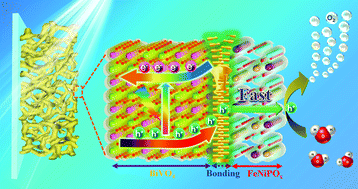High-performance and stable BiVO4 photoanodes for solar water splitting via phosphorus–oxygen bonded FeNi catalysts†
Abstract
Solar-driven photoelectrochemical water splitting is a promising technique for solar energy conversion, while its practical application is currently hampered by the sluggish oxygen evolution kinetics. Herein, we report that phosphorus–oxygen bonded FeNi catalysts and BiVO4 photoanodes could significantly promote the PEC water oxidation activity and stability. More specifically, a record photocurrent density of 6.73 mA cm−2 at 1.23 V (vs. reversible hydrogen electrode (RHE), AM 1.5 G) has been achieved, accompanied by an outstanding long-term durability. The detailed experimental and analysis results clearly reveal that the incorporation of P–O interfacial bonds leads to electron density redistribution and strong electronic coupling between the FeNi catalysts and BiVO4 photoanodes. More specifically, such interfacial features not only promote the electron transfer from Bi sites to Fe atoms for significantly enhancing the PEC activity but also facilitate the electron injection from Ni atoms to the V site for stabilizing the V atom in the BiVO4 lattice to guarantee structural stability. This work provides a new insight for designing highly efficient photoanodes for solar water splitting applications.



 Please wait while we load your content...
Please wait while we load your content...